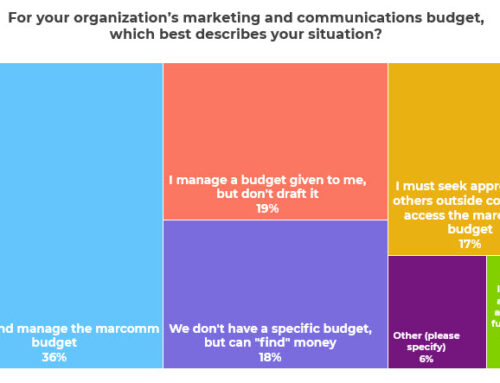You set goals, like these twelve communications goals for nonprofits, including community engagement, raising awareness of issues, and fundraising.
And every day you manage tactical communications channels like email, social media, print marketing, PR and more.
But what’s in the middle? What connects that tactical work to the larger goals? The answer is Communications or Marketing Strategies.
Unfortunately, if you spend much time searching for nonprofit communications strategies what you most often find is content about goals or tactics.
So, I put some time in sorting through and narrowing down the 12 communications strategies that I most often see effective nonprofits using. A combination of tactics can be used to implement these strategies and these strategies can be combined to achieve your goals.
Here they are:
PERMISSION-BASED MARKETING is sharing content with specific people who have signed up, subscribed, or otherwise agreed in advance to join your mailing lists and lists of social followers. Nearly all nonprofits use this strategy in some way by building opt-in mailing lists. Of course, some do it much better than others!
UNSOLICITED DIRECT RESPONSE MARKETING is using mail, email, phone calls, and other communications tactics to communicate directly with people who have not previously opted-in to communications with you. It usually includes direct calls to action sent to purchased/rented lists of names. We most often see this strategy in play as direct mail acquisition fundraising.
GENERAL ADVERTISING is the placement of content into online, print, and broadcast channels meant to reach a targeted or general audience, rather than specific individuals. It can include everything from free flyers posted on bulletin boards to paid advertising in print and remarketing ads on social media. This is another popular strategy for nonprofits, especially via social media advertising.
CONTENT MARKETING is attracting people to your work and retaining their interest in it by creating and distributing content they find especially valuable and relevant. It is also sometimes called Inbound Marketing. Just because you are doing Permission-Based Marketing doesn’t mean you are doing Content Marketing! I wrote a whole (award-winning!) book about the differences.
EVENT or EXPERIENCE MARKETING is using frequent events or participatory experiences to promote your programs and services, encouraging in-person interaction between your organization, supporters, and/or program participants. Sometimes it is hard to tell if nonprofits are marketing programmatic events or if the events themselves are the marketing, but generally speaking, if you are using events or other experiences to encourage people to take some other kind of action (not just attending the event), then you are probably doing Event Marketing.
SEARCH MARKETING is gaining traffic and visibility from search engines through both search engine optimization of content and paid search listings. Rather than just throwing content up on your blog or website, are you paying attention to what topics bring traffic to your site and writing to encourage the right kind of traffic? Are you managing a Google Ad Grant? If yes, you are doing Search Marketing.
WORD OF MOUTH MARKETING is encouraging verbal or written recommendations or testimonials to be shared from one person to another. It relies heavily on casual, unplanned social interactions between people. Sure, some of this happens on its own. But are you actively encouraging people to talk about you with their friends and family by giving them interesting things to share? Are you asking people to post about you on review sites? That’s encouraging Word of Mouth Marketing.
INFLUENCER or AMBASSADOR MARKETING is creating relationships with people with special influence or access to a broader group of people you wish to reach. Influencers can include celebrities, bloggers, market leaders and anyone else who acts as a gatekeeper who decides whether to pass on your information to their communities. This strategy is especially important for nonprofits who are several steps removed from the people they are trying to affect in some way. A good example is an education think tank that wants to change how children learn in the classroom. They need to influence the people who make the decisions about teaching.
PARTNER or ALLIANCE MARKETING is cooperating with other organizations to jointly promote your cause generally or your specific products or services. It can include referral marketing, affiliate marketing, co-branding, and cause marketing. Examples of Partner Marketing include several nonprofits collaborating on a one-stop-shop service center for clients, private sector businesses referring customers to nonprofits or collecting donations at the cash register, and museums in a geographic area buying advertising together.
PEER-to-PEER MARKETING is organizing and training volunteers to educate or advocate on your behalf. You work with individuals, but also support the community of peer educators or activists as a whole. Peer-to-Peer marketing is more organized and actively managed than Word of Mouth Marketing and involves many more people than Influencer Marketing. Peer-to-peer fundraising gets a lot of coverage in our sector, but fundraising isn’t always the goal. Get Out the Vote operations by political campaigns are a good example of peer-to-peer marketing.
RELATIONSHIP MARKETING is creating strong, long-term, loyal relationships with specific individuals and focusing on the quality of those relationships, rather than on individual transactions with those individuals. While the individuals will take a variety of actions in support of your nonprofit over the course of the relationship, their overall engagement with your cause is paramount. Major donor fundraising programs are often built on relationship marketing strategies.
LOCATION-BASED MARKETING is using mobile phone location data to provide messaging to people when they are physically near specific locations or when they use apps to check-in at specific locations. Includes Geomarketing and Proximity Marketing. We most often see this now with nonprofits that run public facilities like zoos and museums, but I bet we’ll see a lot of innovation with this strategy in the years to come.
Which Strategies Go with Which Goals?
How Do You Change the Way You Use a Tactic Depending on the Strategy?
Now, you might be wondering exactly how nonprofits are pairing these strategies with different goals and what kinds of nonprofits are using these strategies. You might also wonder how your use of communications tactics like email or social media might change depending on the strategy selected from this list.
We’ll be blogging a lot more about that in the next month or two.
We’ll also have some great data to share with you in January when we release the 2019 Nonprofit Communications Trends Report.
I’m also teaching a new two-part webinar series on January 8 & 10 called Communications Planning That Works: Getting Your Goals, Strategies, Objectives, and Tactics Right in 2019.





